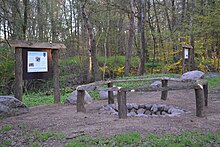Gödenstorf shaft furnace
The shaft furnace in Gödenstorf in the Harburg district in Lower Saxony was discovered during sand mining in 1935 and excavated by Willi Wegewitz after the site was reported by the Helms Museum Hamburg . In 1979 the remains of the prehistoric shaft furnace south of Gödenstorf were restored.
description
A community-owned sand pit is located in the Feldmark on a hill to the south-east of the community of Gödenstorf . Construction sand was extracted here in the 1920s and 1930s. In the course of the sand mining, graves from the older Bronze Age (1500–1200 BC) were discovered in May 1935 . The then mayor reported a very endangered barrow to the Archaeological Museum . During a tour that was immediately initiated, a total of five barrows, some of which had already been severely destroyed, were found. The sixth finding, a stone pack that was reported as the endangered grave, turned out to be the upper stone wreath of a shaft furnace on closer examination.
The furnace was researched by the archaeologist Willi Wegewitz (1898–1996). The system contained a complete funnel-shaped stone casing that reached about 1.80 m into the ground. The upper edge was oval with an inner dimension of 1.80 m by 1.55 m. The floor was more rectangular in shape (0.92 × 0.83 m).
After a 30 cm thick layer of humus had been removed , red-burnt clay chunks were found, some of which were even traces of wickerwork - parts of an above-ground clay ceiling. The other filling of the furnace consisted of clay rubble up to a depth of 1.40 m, which was detached by a layer of fire that reached down to the lowest stone wreath and to the ground. This layer contained loose, black, carbonaceous, greasy soil in which also whole pieces of charcoal and part of a burnt deer antler were found. In addition, pieces of an older clay ceiling lay in the rubble, which prove that the furnace was used for at least two firing processes. The upper part of the stone wreath, consisting of four to five layers of unprocessed field stones, showed no signs of fire. On the other hand, the lower stones were burned black up to a height of 0.40 m above the ground.
In addition to the remains of the burnt antlers, isolated fragments could be found, which allow a date to the 1st century AD.
On the old signs, the Gödenstorf oven is still referred to as an oven , according to the excavator's original interpretation . According to the old interpretation of the oven for roasting, drying (served Darre ) or baking flat bread. According to today's doctrine, it is definitely a technical monument for the production of quicklime.
In 1979, the Helms-Museum completely restored the stove with the help of the Salzhausen community. In 2016, the exterior design of the shaft furnace, including the neighboring mound, was redesigned with the support of the Archaeological Museum Hamburg and the Museum's practical archeology group, the Salzhausen community and the Harburg district .
Construction and use of shaft furnaces
The production of quicklime in so-called shaft furnaces is a constant companion of Iron Age settlements in northern Central Europe, from Lower Saxony to Poland . The ovens can be used from around 400 BC. BC to 500 AD on the edge of many settlements, which illustrates the importance of this branch of trade. The basic shape of the individual stoves is stereotypical, but the details are quite variable and depend on the building materials available. Stone installations have often been dispensed with in stable soils, whereas stone surrounds or complete stone casings have been installed regularly in sandy subsoil. Otherwise, the firing pit was mostly round or oval and slightly cylindrical, the depths are very different. These ovens have been used many times over.
In most cases, the starting material for the quicklime is likely to have been meadow lime , i.e. deposits of plants, mussels and snails in silted lakes or dead ice holes . Such deposits can be between a few centimeters and several meters thick. Lime lumps in marly soils also seem to have been degraded.
Archaeological firing tests show that stoves heated with wood in a process lasting several days could easily heat up to 900 ° C, with peaks reaching over 1000 ° C. The archaeological findings of the shaft furnace also regularly show annealed stones and a heat bricking of the surrounding soil, so that it was a high-temperature furnace.
The quicklime produced in this way was used in a wide variety of ways, including as a dye (e.g. for painting everyday objects made of clay, wood and also for whitewashing house walls), as a filler in recessed decorations, for building houses (adding lime to building clay), For processing raw hides and as a depilatory agent, for cleaning and polishing horn, leg and metal work, as a fertilizer to improve the quality of the soil, as well as for bleaching and dyeing.
Web links
literature
- Willi Wegewitz : Settlements from the older Iron Age in the Harburg district . 1935, pp. 65-76.
Coordinates: 53 ° 12 '54.1 " N , 10 ° 6' 58.4" E

